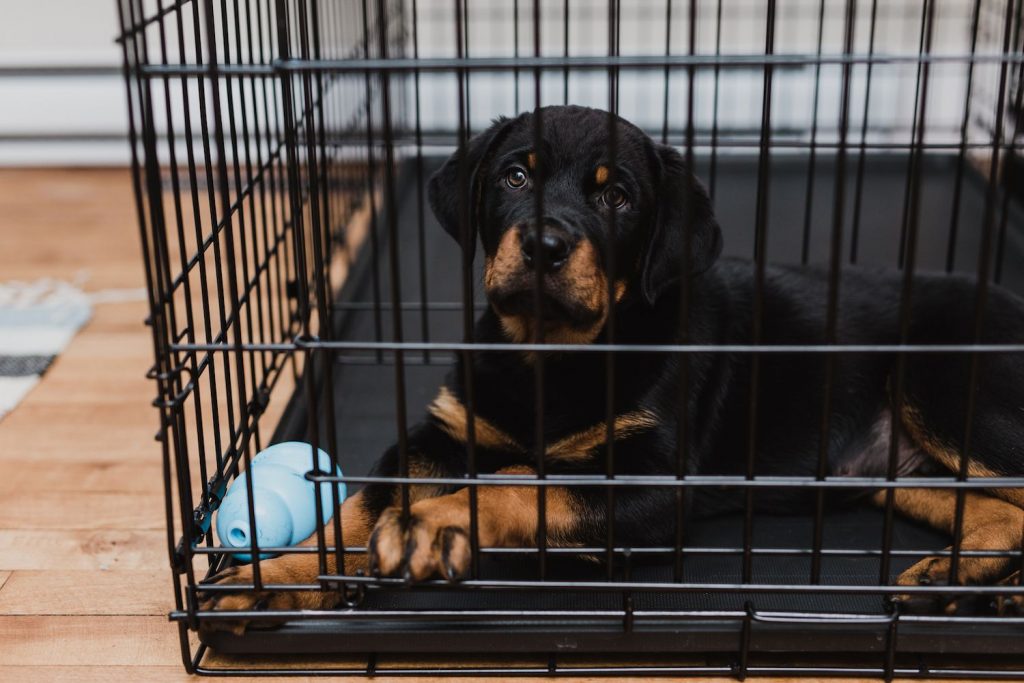Would you leave your baby in a crib all day? Than why are we confining our dogs? Crate training in North America is unfortunately the most common way people house train a dog. But have you ever considered how many hours your dog is locked up?
Many people lock their dog up to go to work, that can add up to 8 hours a day or more! Countries like Europe have actually made crate training illegal, except for common sense tasks such as travel, veterinarian appointments and post-operative protection so the dog does not over exert themselves and injure their surgical wound, or impede their healing process.
Next time you crate your dog, watch the time. Limit yourself to a maximum of 2 hours. Think about why you are crating them, are you leaving the house, going to work? Do you crate out of convenience while you work or clean in another part of the house? Or do you crate out of punishment? – To enforce a loss of freedom or privilege with your dog so your dog will “learn a lesson”.

Alternatives to Crate Training
Many dog owner’s don’t realize there are other alternatives to crate training. They hear about dog walkers and dog daycare and worry about the cost. Understandable, if you need to pay for your dog to be entertained while you are at work 5 days a week! 30$ a day would add up pretty quickly and it’s easy to see how the crate becomes the alternative. But there are other ways.
Consider sending your dog to dog day care on a part-time basis; only every other day. You can cut-down your time you spend with dog walkers in the same way.
Similar to having a human child, do you have friends or family who may be willing to pitch in as a favor once in a while and dog-sit while you are away?
For a more permanent and logical solution my best suggestion is to create a dog-proof area in your home. If you have lots of space, you can devote a room.
If you are in an apartment, decide on a designated area that you can spare. Consider using baby gates or other alternative ways to create a blocked off area that can be opened and shut to control accessibility. But is more like a room, even a small room, than a small cage.
“We support graduated transition out of crating in the home and into the dog being comfortable home alone and having free run of the house, such as being let out in a smaller room unsupervised. This doesn’t mean doing away with crates entirely. Shifting to having a crate with the door open so dogs can self-select versus being forced in can be very helpful.”
Helen Prinold, M.Sc. Animal Behaviour CPDT-KA, CDBC, Certified Fear Free Professional and Chair of the Canadian Association of Professional Dog Trainers.
How to Use A Dog Crate The Right Way
To introduce crate training to your dog, make it enjoyable in a supportive environment. Do not force your dog into the crate and lock the door.
- Place the crate down in a common area. Place a blanket and some toys inside. Provide some treats inside the crate for positive reinforcement.
- Let the dog go in, sniff and come out. Leave the door open. Do this over several days.
- Give your dog time to get used to the crate, feel that it is nothing to be threatened by.
- Eventually when your dog shows comfort in the crate, show the dog that the door can be closed. Only close the door for 2-5 minutes at first. Watch your dog for signs of stress while you go about your day.
- After the 2-5 minute mark, unlatch the door and open it.
- Do not encourage your dog to come out. Let your dog explore that now the privilege to exit has been given.
You can extent the length of time your dog spends in the crate to get them used to it. Work up slow from 5 minutes to 10-15 minutes to 30 minutes and 1 hour. Remember to go slow over days and a week or 2. Use the crate as part of your regular daily training routine. Do not wait until you NEED the crate and then have to shove your dog in at the last minute without a proper crate training introduction.
Examples of Great Dog Spaces
This set up is fantastic!
Dog Training is Evolving
Just like everything with our furry friends, their veterinarian care has evolved, their role is our families has evolved, training is less about punishment and more about supportive, positive reinforcement. So our crate training strategies also need to evolve. Dogs where meant to play, to exercise, to enjoy their surroundings to run, jump and roll. Crate your dog only as necessary for travel, and appointments. Otherwise, create opportunities to let them be dogs, not caged animals. So as I say,
“Don’t Crate – Create!”
Tell us about your dog’s space, Post a Picture!
References
https://www.humanesociety.org/resources/crate-training-101

dog seizures are common. Learn why dog seizures occur and how to prevent reoccurrences
https://discover.hubpages.com/animals/Seizure-Causes-and-Treatment-in-Dogs

